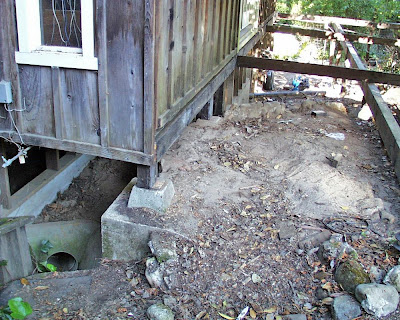 Why it's called "Fort Harrington." Photo taken shortly after the new fence, gate, and sign were installed in October, 2001.
Why it's called "Fort Harrington." Photo taken shortly after the new fence, gate, and sign were installed in October, 2001.If you're going to buy a fort in a rain forest, don't buy one that's downhill from a road and uphill from the nearest creek.
If you're going to buy a fort in a rain forest, and it's downhill from a road and uphill from the nearest creek, be prepared to deal with drainage issues. Voluminous ones.
Fort Harrington lies between a paved mountain road and Kings Creek in the Santa Cruz Mountains of California, a little patch of rain forest on California's central coast. Our area receives about five feet of rain per year on average, almost all of which falls between October and April. The abundance of rain is due to a little kink in the San Andreas fault, which takes a sudden right turn between Santa Cruz and Palo Alto. That abrupt change in direction, over the aeons, has birthed the Santa Cruz Mountains, a two- to three-thousand foot uplift directly adjacent to the prevailing westerlies from the Pacific. That uplift, in most years, wrings cascading amounts of water out of the laden oceanic air in winter, and feeds our spectacular forest of millions of sequoia sempervirens (coast redwoods).
It also feeds a sluiceway directly through our compound, which blasts away merrily at impressive volume during winter storms. The road above us makes a little turn there, a micro-mirror of the San Andreas's jig, but its turn is in a depression, not an uplift. At the depression in the road above us is a storm drain, which channels all the road's runoff from both directions for a long way down underneath our property to the creek below.
Right under our garage.
Right under our house.
 When the decking was being replaced in mid-2000, stripping the old decking away exposed the sluiceway's transition to under-house pipe, seen at lower-left here.
When the decking was being replaced in mid-2000, stripping the old decking away exposed the sluiceway's transition to under-house pipe, seen at lower-left here.The portions of the runoff's course under the structures are large-caliber pipe, from a foot and a half to two feet in diameter. Between the "garage" (a 1930's shed, which is being held up only by vines, as far as I can figure) and the house, though, it runs through a deep, v-shaped, exposed sluice.
When we purchased Ft. Harrington in 1998, many things were in an advanced state of rot, including the simple plywood covering of the 30 feet of sluiceway (and all the decking). Our first renovation projects were fencing around the entire compound (which my sons Doug and Adam were the primary architects and laborers for), replacing the decking (which we put in the hands of a well-respected local contracting firm, along with a large chunk of our bank account), and covering the sluice. I did the latter, fashioning a plank walkway over it with redwood two-by-fours.
That was in early 1999. Now I know how long untreated redwood two-by-fours at ground level last in a rain forest environment: ten years.
My over-sluice walkway had decayed to the point of disintegration by this summer, so re-building it has been item one on my list of honey-dos this fall. Luckily, the big rains have held off long enough for me to progress on the project pretty much adequately before the sluice becomes a torrent.

I started a few weeks ago, before the first big storm of the season. The above photo shows the old walkway; its unevenness is due to rot in the boxes that support the cross-boards. At the back end of the sluiceway, near the "garage," you can see three new boxes that will ultimately support new crossboards. The walkway/sluice covering is modular to allow easy access to the sluice, which provides an avenue for water pipes to outlying areas of the Fort, such as the chickens' compound and the garden house (note the white pvc pipe in the sluice in some of these photos.)
 The first few boxes were temporarily covered with plywood; they will eventually be covered by a lattice of two-by-fours. A new box is ready on the table at left. Some 8-foot redwood 2x4's stand ready to be chopped up, leaning against the chickens' mansion in the background.
The first few boxes were temporarily covered with plywood; they will eventually be covered by a lattice of two-by-fours. A new box is ready on the table at left. Some 8-foot redwood 2x4's stand ready to be chopped up, leaning against the chickens' mansion in the background.
Cross-pieces halfway done. The cross-pieces probably could be made with thinner boards than two-by-fours, but I like the sturdy feel of the thicker wood under my feet. What I can't logically rationalize is my choice of fastener: 2 1/2 inch lag screws instead of nails. That's just how I do stuff; if I were doing this kind of thing for a living, you bet I'd do it cheaper, faster, and more logically. I just like the way a walkway cover box that could support a tank feels. (Somewhere, my Dad -- a fine craftsman in woodwork -- is rolling his eyes.)
 Finishing today's job as today's light fades.
Finishing today's job as today's light fades.There's a certain comfort in knowing when I'll have to do this job again. The first walkway decayed to dangerousness in ten years, so I should probably replace this one in nine. So I'll mark it on my schedule: "re-build sluice cover" in summer, 2018.
When I'm 71.
Maybe I'll rope my son, Adam, into helping me out then. He'll be a mere tyke, still, at 48. But I'll still work the power tools, yeah.
When I'm 71.
Maybe I'll rope my son, Adam, into helping me out then. He'll be a mere tyke, still, at 48. But I'll still work the power tools, yeah.
 All the while I was working today, our Japanese maple was in my field of view, its exuberant November red catching my vision's periphery. It is planted in the decaying stump of a magnificent old virgin-forest redwood, and it's of a variety called "Sherwood's Flame"... which, of course, is why we bought it at the local nursery.
All the while I was working today, our Japanese maple was in my field of view, its exuberant November red catching my vision's periphery. It is planted in the decaying stump of a magnificent old virgin-forest redwood, and it's of a variety called "Sherwood's Flame"... which, of course, is why we bought it at the local nursery.



6 comments:
Somewhere, your first born -- a fine craftsman in woodwork -- has got his thumbs up.
From what I see here, our inevitable project might start closer to 2028.
You done good Popsie.
Shouldn't you be installing dynamos in the sluiceway to capture all that otherwise wasted energy and lower your carbon footprint?
I figure the payback would come ... well, you'd have to make sure you saved them in the next round of rebuilding ...
I'd want it to be able to hold up a tank too. Do you have to clean out those sluices, like gutters, or does the incline and nature take care of that? Either way, i would find the water's course going directly under the house very ... nervewracking!
Beautiful. I built a redwood boardwalk of similar construction running along the side of our first house where the ground sloped away from the foundation. I went with wood primarily because I didn't know how to do concrete, and it looked great. Still there 20 years later, as far as I know. I also built a redwood wheelchair ramp at Mom's house in Hollywood. Sadly, it wasn't needed for more than a year or so. Redwood is a great material to work with.
I guess you need the walkway, but did you ever consider just laying down some river rock and making it into a creek?
Brian has a great idea! but your place looks a lot like PARADISE to me!
and what beautiful work on the walkway!
Adam, as long as I don't use treated redwood, the sturdiness of the construction won't influence how long it resists rot. Unlike the way we're constructed, which influences the way we degenerate a great deal.
Mike, I'll do that as soon as I can figure out how to make a turbine entirely out of 2x4s and lag screws.
Ruth, generally the slope and significant hydraulic power of the rushing water takes care of the detritus. When it doesn't, though, things get... interesting (as Adam can attest), so I do like to clean it out before the rainy season begins. Another reason for the modular boxes, rather than a more integrated covering.
Brian, that's a great idea. I'm not so sure how it would work in practice, though -- I'd worry about debris building up in and blocking the interstices between the stones and ultimately clogging the runoff. The only remedy then would be to remove all the stones, which would be a bit more labor than I'm willing to contemplate.
And thank you, Mary Ellen!
Post a Comment